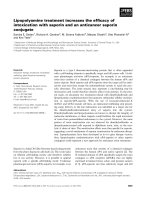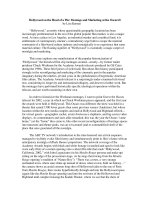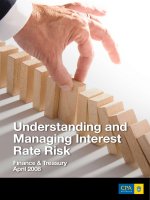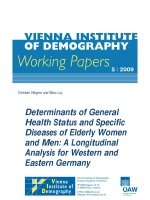ABC of sexual health: Assessing and managing male sexual problems doc
Bạn đang xem bản rút gọn của tài liệu. Xem và tải ngay bản đầy đủ của tài liệu tại đây (447.12 KB, 4 trang )
1999;318;315-317 BMJ
Alain Gregoire
male sexual problems
ABC of sexual health: Assessing and managing
/>Updated information and services can be found at:
These include:
References
/>1 online articles that cite this article can be accessed at:
/>This article cites 5 articles, 2 of which can be accessed free at:
Rapid responses
/>You can respond to this article at:
service
Email alerting
the top left of the article
Receive free email alerts when new articles cite this article - sign up in the box at
Topic collections
(2317 articles) Urological surgery
(3785 articles) Sexual health
(298 articles) Sexual and gender disorders
(5899 articles) Reproductive medicine
(772 articles) Drugs: obstetrics and gynaecology
(1033 articles) Contraception
(7292 articles) General practice / family medicine
Articles on similar topics can be found in the following collections
Notes
/>To Request Permissions go to:
/>To order reprints go to:
/> go to: BMJTo subscribe to
on 17 May 2009 bmj.comDownloaded from
ABC of sexual health
Assessing and managing male sexual problems
Alain Gregoire
Assessing problems
Men are more likely than women to present with and receive
treatment for sexual problems. Nevertheless, they usually find
them very difficult to talk about, and an initial perception that
their problem is being dismissed can considerably delay or
prevent their seeking further help. Time spent establishing as
clearly as possible the nature of the problem is well spent, as it
should lead to more effective treatment and may be therapeutic
in itself. Likewise, talking to the partner can reveal a very
different picture and can substantially alter management as well
as have a therapeutic impact.
1
Sometimes quite simple interventions
—
information,
reassurance, contraceptive advice, or an opportunity to talk to a
member of the primary care team with some basic problem
solving or non-directive counselling
—
can resolve problems that
have been a source of considerable distress to patient and
partner. Suggesting sources of self help information such as
books on sexuality can also be valuable.
When the problem persists despite primary care
intervention, further help from other services can be sought,
although the provision of services for sexual problems in
Britain is variable and rarely enough to meet demand.
Optimum assessment and treatment is provided in a
multidisciplinary setting, but such clinics are scarce and most
patients will be referred to services that have a particular
approach. The choice of where to refer a patient will therefore
have a critical effect on treatment and, possibly, outcome.
Classification of sexual dysfunction
The accepted diagnostic categories for sexual dysfunction
described in ICD-10 (international classification of diseases,
10th revision) and DSM-IV (Diagnostic and Statistical Manual of
Mental Disorders, fourth revision) do not reflect the reality of
sexual dysfunctions in the clinical setting. When these
classifications are used it must be remembered that
x Sexual dysfunctions are not all or nothing phenomena but
occur on a continuum both in terms of frequency and severity.
With our current knowledge, any cut off is inevitably arbitrary
x It is rarely possible to identify cases with a purely organic
or purely psychogenic aetiology. Indeed, with our growing
knowledge of psychoneuropharmacology and endocrinology,
the distinction between organic and psychogenic becomes
increasingly blurred
x Comorbidity of sexual dysfunctions is common. For example,
nearly half of men with low sexual desire have another sexual
dysfunction, and 20% of men with erectile dysfunction have low
sexual desire.
In addition to the intrapersonal complexity of sexual
problems, the patient’s partner and their relationship probably
have a more profound effect on sexual health than on any other
aspect of health. In up to a third of patients with sexual
problems, the partner also has a sexual dysfunction. The
interactions between various aspects of sexual problems
experienced by a couple are complex, often circular, and rarely
reveal simple causal or consequential relationships.
What constitutes a sexual problem?
x Physiological dysfunction
x Altered experiences
x Own perceptions and beliefs
x Partner’s perceptions and expectations
x Altered circumstances
x Past experiences
Male Female
Inadequate
stimulation
Inadequate
stimulation
Inadequate
arousal
Inadequate
arousal
Infrequency
of sexual
intercourse
Infrequency
of sexual
intercourse
Sexual
dissatisfaction
Erectile
failure
Sexual
anxiety
Anorgasmia
Sexual
dissatisfaction
Dissatisfaction
with general
relationship
Dissatisfaction
with general
relationship
The complex interactions of effects of sexual relationship and general
relationship between partners. (Adapted from Gregoire A, Prior JP. Impotence.
Edinburgh: Churchill Livingstone, 1993)
Clinical review
315BMJ VOLUME 318 30 JANUARY 1999 www.bmj.com
on 17 May 2009 bmj.comDownloaded from
Inhibited sexual desire
Abnormalities of sexual desire, and indeed sexual desire itself,
are difficult to define.
2
The factors considered by clinicians and
patients when gauging desire include sexual fantasies, arousal,
thoughts, and activity. Given the confusion over the meaning of
the concept, it is not surprising that views differ over the term
that best describes it. The ICD-10 uses the term sexual desire,
and other terms include sexual drive and sexual interest, but
“libido” is no longer favoured.
Sexual fantasies, the desire for sexual activity, and distress
about the level of desire in a patient and his partner all
contribute to the construct of inhibited sexual desire. It is more
commonly reported in women than in men (by both women
and men) in the general population and in clinic populations.
Differences in sexual desire often lead to considerable distress
for a couple and can be a source of major conflict in the
relationship.
Inhibited sexual desire is often associated with other sexual
dysfunctions in the patient or partner. The lifetime prevalence
of depression and anxiety disorders is increased. There is a
strong association with emotional distance and conflict within a
relationship, although it is impossible to determine whether this
is cause or consequence from the studies available. Indeed, it is
probably meaningless to attempt to do so from population
studies given the great individual variability and the very
gradual, transactional nature of change in these aspects of
relationships.
Characteristic cognitive features have been identified in
many cases
—
for example, the belief that desire does not
gradually develop during a sexual encounter but must either be
present at the start or does not occur at all, and the belief that
subtle feelings such as warmth or tenderness are not sexual and
that sexual arousal cannot take place without intense, overtly
erotic feelings.
Sexual desire in men can be inhibited by a wide range of
physical factors. This can be due to the general effects of illness
such as a severe bout of flu or chronic renal failure or to specific
effects such as those seen in alcoholism, liver disease,
testosterone deficiency, and prolactin secreting pituitary
tumours (which may occur in as many as 10% of men
presenting with inhibited sexual desire). It is also often a side
effect of drugs such as antihypertensives, antidepressants and
antipsychotics, anticonvulsants, and cytotoxic agents.
Most studies of outcome indicate that response to
psychological intervention for inhibited sexual desire is very
poor.
3
Erectile dysfunction
Erectile dysfunction is dealt with in more detail in the next
article of this series. It occurs in 10-15% of men but varies with
age, with some degree of dysfunction being experienced by
40% of men at age 40 and by 70% at age 70. In most cases there
are both organic and psychological aetiological factors, and
assessment and treatment must take account of this.
Various treatments are available, but data on their relative
effectiveness and long term outcome are still lacking. Although
it is clear that there is no ideal treatment, there is usually one
that is both effective and acceptable to the man and his partner.
Sildenafil represents an important advance but seems to be a
victim of its own success, with concerns about costs leading to
limitations on prescription as well as there being evidence of
misuse.
4
Premature ejaculation
Premature ejaculation is an inability to control ejaculation
sufficiently to permit both partners to enjoy sexual intercourse.
Treatments for erectile impotence
x Simple measures
—
education, advice, self help
books
x Psychological
—
therapy for couples or for single
men individually or in groups
x Oral drugs
—
sildenafil
x Topical vasodilators
x Intracavernosal drugs
—
prostaglandin E
1
x Vacuum devices
x Prosthetic implants
x Surgery for venous leakage
Differences in sexual desire often lead to considerable distress for a couple
and can be a source of major conflict in the relationship
Sexual desire can b e inhibited by physical factors such as the effects of
illness. (Francis Matthew Schutz in his Bed (circa 1755-60) by William
Hogarth)
“A hard man is good to find” Mae West
Clinical review
316 BMJ VOLUME 318 30 JANUARY 1999 www.bmj.com
on 17 May 2009 bmj.comDownloaded from
This may result in ejaculation shortly after penetration or, in
severe cases, before penetration.
Sometimes the true problem is an erectile difficulty that
necessitates prolonged stimulation in order to achieve adequate
erection, and there is therefore an apparently short period
before ejaculation. About 20% of men complain of premature
ejaculation, and in the vast majority of cases there is no
evidence of any physical underlying cause. Premature
ejaculation is commoner in younger men, and it is likely that
there is a process of learning to control ejaculation with
increasing sexual experience. Anxiety undoubtedly plays an
important role in hastening ejaculation in some men.
Psychological interventions are aimed at reducing
performance anxiety and improving ejaculatory control
—
such
as by the “pause and squeeze” technique. Reported success rates
are conflicting, and long term follow up suggests that benefits
are not maintained.
5
Drug treatment with specific serotonin reuptake inhibitor
antidepressants such as sertraline 50 mg daily are effective in
delaying ejaculation and improving sexual satisfaction in patient
and partner. Recent studies indicate that intermittent use can be
as effective as continuous use, and this should reduce the rates
of undesirable side effects such as nausea and decreased desire.
Retarded and absent ejaculation
Retrograde, absent, or retarded ejaculation caused by drug side
effects are seen fairly frequently in clinic populations, although
many sufferers do not spontaneously complain but simply stop
their medication. Common causes include antidepressant and
antipsychotic drugs as well as prostatectomy. Cases not
associated with these obvious causes are rare.
Psychological treatment focuses on reducing anxiety and
increasing arousal. Increased genital stimulation is important,
and patients sometimes need encouragement and “permission”
to pursue this, including using aids such as a vibrator. One
successful option for treating antidepressant induced
anorgasmia is the adjunctive use of cyproheptadine (2-16 mg)
before sexual intercourse. However, this is a serotonin
antagonist and has been reported to cause relapse of the
depression in some cases.
Dyspareunia
Genital pain before, during, or after intercourse is rare in men,
occurring in about 1% of clinic samples. The cause can be
physical, such as genital infection, phimosis, and prostatitis, or
psychological. There are at present no outcome studies of
psychological treatments for this distressing problem.
Alain Gregoire is consultant psychiatrist at the Old Manor Hospital,
Salisbury, and honorary senior lecturer at the University of
Southampton.
The ABC of sexual health is edited by John Tomlinson, physician at
the Men’s Health Clinic, Winchester and London Bridge Hospital,
and formerly general practitioner in Alton and honorary senior
lecturer in primary care at the University of Southampton.
The cartoon “I’d loosen his flies. . .” is reproduced with permission of Punch
Publications. The painting by Hogarth is reproduced with permission of
the Bridgeman Art Library. The cartoon “Can’t you at least try?” is by
Neville Spearman.
1 Ackerman MD, Carey MP. Psychology’s role in the assessment of erectile dysfunction:
historical precedents, current knowledge and methods. J Consult Clin Psychol
1995;63:862-76.
2 Gayle Beck J. Hypoactive sexual desire disorder: an overview. J Consult Clin Psychol
1995;63:915-27.
3 Hawton K. Treatment of sexual dysfunctions by sex therapy and other approaches. Br J
Psychiatry 1995;167:307-14.
4 Gregoire A. Viagra: on release. BMJ 1998;317:759-60.
5 Rosen RC, Leiblum SR. Treatment of sexual disorders in the 1990s: an integrated
approach. J Consult Clin Psychol 1995;63:877-90.
BMJ 1999;318:315-7
Sources of further help for patients*
Relate
—
Local availability of services and waiting lists vary across the
country. A fee is charged. Will usually see people individually but
prefer to see couples together. Offer marital as well as sexual
counselling
Family planning clinics
—
Sometimes also offer psychosexual
counselling services
Brook advisory centres
—
Usually provide advice and sexual
counselling. Particularly suitable for young adults
Urology clinics
—
Usually assess only organic causes and provide
physical treatments, mainly for erectile dysfunction
Psychiatry departments
—
Now rarely do any work with sexual
problems as priority is given to serious mental illness. Some
psychiatry departments have special clinics for sexual problems
Sexual dysfunction clinics
—
The better clinics are multidisciplinary and
can assess both psychological and organic aspects of a problem and
can provide psychological and physical treatments. These clinics
probably offer the best service, but there are few of them and
waiting lists tend to be long
*List of clinics available from the honorary secretary, British Association of
Sexual and Marital Therapy, PO Box 62, Sheffield S10 3TS
Recommended further reading
x Bancroft J. Human sexuality and its problems. 2nd ed. Edinburgh:
Churchill Livingstone, 1989
Although this book is now a little old and in need of revision in
some areas (such as management of erectile dysfunction), it remains
one of the best comprehensive textbooks in the subject
x Gregoire A, Prior JP. Impotence: an integrated approach to clinical
practice. Edinburgh: Churchill Livingstone, 1993
A comprehensive textbook covering psychological and physical
aspects of erectile disorders and their management
x Baldwin D, Thomas S. Depression and sexual function. London:
Martin Dunitz, 1996
Available from Bristol Myers Squibb Pharmaceuticals
The “pause and squeeze” technique can be used to try to improve
ejaculatory control. (Illustration for The Book of Lust (1920-30) by Pierre
Lacombière)
Clinical review
317BMJ VOLUME 318 30 JANUARY 1999 www.bmj.com
on 17 May 2009 bmj.comDownloaded from









